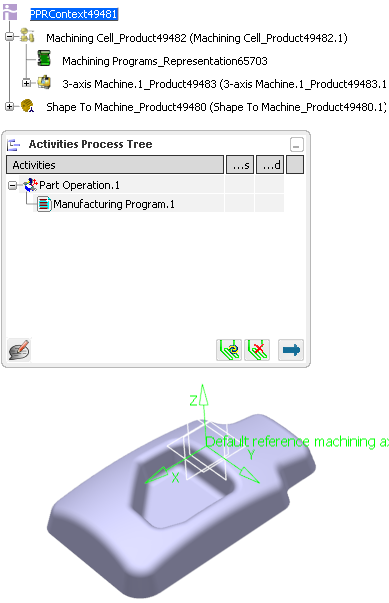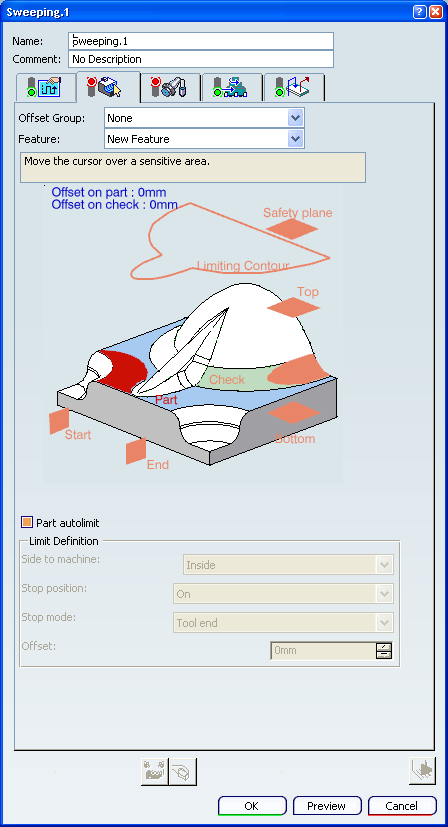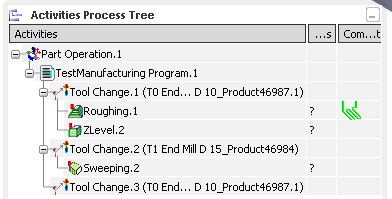Creating a Machining Operation | ||||||
|
| |||||
From any product:
- Select Start > Machining > Machine Programming.
A PPR context with an empty Machining Cell is created. An empty Activities Process Tree opens automatically.
- Create a generic machine or assign a machine from the database.
As soon as a machine is assigned to the Machining Cell, a Part Operation and a Manufacturing Program are created in the Activities Process Tree.
- Alternatively, open an existing Machining Process or PPR context .
 By default,
the
Activities Process Tree opens
automatically.
By default,
the
Activities Process Tree opens
automatically.

- Select Start > Machining > Machine Programming.
Click one of those icons to access the Machining Operation icons:
 Prismatic Machining Operations
Prismatic Machining Operations Surface Machining Operations
Surface Machining Operations Lathe Machining Operations
Lathe Machining Operations Axial Machining Operations
Axial Machining Operations
The corresponding Machining Operation icons are displayed in a toolbar, e.g.

In the example below, we create a Sweeping operation. The operating mode is similar for all Machining Operations. See the Interface description in the Prismatic Machining User's Guide, 3-Axis Surface Machining User's Guide, Multi-Axis Surface Machining User's Guide, Multi-slide Lathe Machining User's Guide for more information on each Machining Operation.
Click the required Machining Operation icon and select a Manufacturing Program or another Machining Operation in the Activities Process Tree.
The Machining Operation dialog box appears.

- It consists of several tabs:
 Geometry.
Geometry. Machining Strategy.
Machining Strategy. Tools.
Tools. Feeds and Speeds.
Feeds and Speeds. Macros.
Macros.
- Their status lights codes are as follows:
- green: all the requested data are defined,
- orange: data are defined, but modifications may be necessary,
- red: data definition is required.
Note:
- The status color codes are as follows:
- green (or the current value of Valuated parameters): all the requested data are defined,
- orange ((or the current value of Optional parameters): data are defined, but modifications may be necessary,
- red (or the current value of Required parameters): data definition is required.
- The colors of Valuated parameters, Optional parameters, Required parameters are defined in Color and Highlight.
- You can display some Machining Operation dialog boxes with a simplified user interface. See User Interface.
- It consists of several tabs:
Still in the Geometry tab, defined the required geometry and other parameters.
See Selecting Geometry.
Go to the Machining Strategy tab.
See
- Defining the Tool Axis,
- Adding a User Parameter,
- and the description of each Machining Operation for more details.
Go to the Tools tab.
Go to the Feeds and Speeds tab.
Go to the Macros tab.
See Defining Macros
Click Tool Path Replay
 to compute and validate the tool path of the Machining Operation.
to compute and validate the tool path of the Machining Operation.Click OK to validate and exit the dialog box.
The Machining Operation is created in the Activities Process Tree, under a Manufacturing Program.

See Creating a Manufacturing Program and Machining Activities for more information about the position of the Machining Operation.